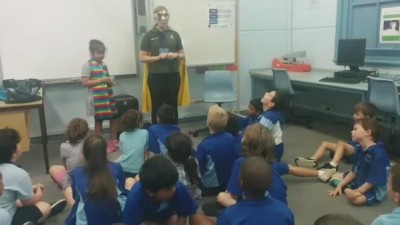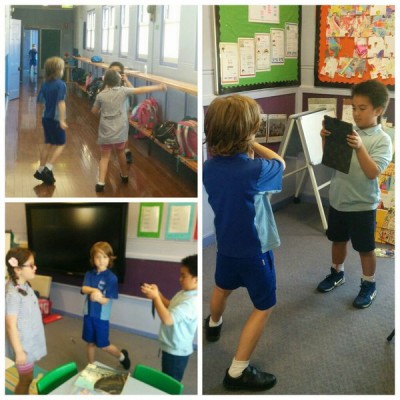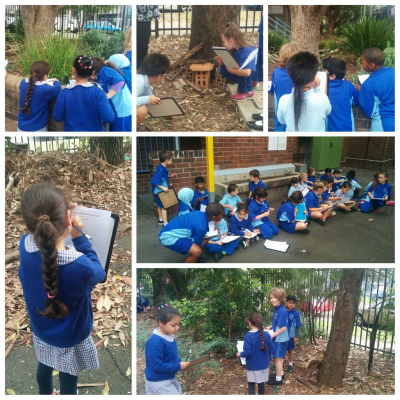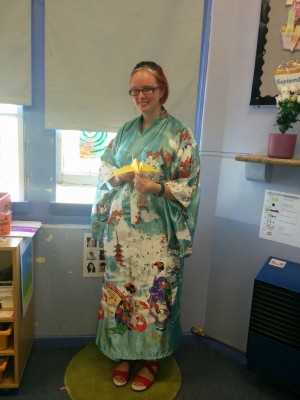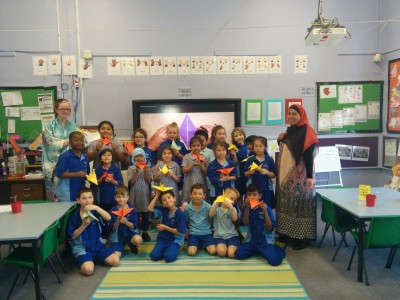Category Archives: Year – 2015
Rhythm and Beat
The beat is the pulse of the music, it is steady and regular. The rhythm is the pattern of sound and silence, usually matching the words or instruments. Watch: who is holding the beat, and who is playing a rhythm pattern?
See how the beat gets faster and faster in ‘Beep Beep‘. (This speed is the ‘tempo’ – more on it later!)
We have already been learning about using symbols to be a shortcut to an idea in our brain. We can use symbols to record our rhythms. I’ve chosen star wars characters as symbols, and in class, we’ll be matching each character to a kind of music note.
An AT-AT has great big giant feet that take a long time to move. This will represent our semi-breve, that lasts for 4 beats.
Darth Vader walks slowly and majestically. He will represent our minim, that lasts for 2 beats.
A Stormtrooper marches or jogs quickly in the imperial army. They will represent our crotchet, that lasts for 1 beat.
C3PO takes lots of little trotting steps. He will represent our quaver, that lasts for 1/2 a beat.
CAPA – by Zana
(Crossposted from http://brightbunch.edublogs.org)
Written and published by Zana
Every week, Belmore South Public School enjoys many things to learn about but one of the most popular is probably CAPA. Lately in CAPA we have been learning about major and minor in music. Major means higher notes that make you happier and minor means lower notes that make you sadder. Here’s a game you can play at home:
Instructions
Get two or more people and take turns. One person plays some music and doesn’t tell you the name of it. The others have to tell the person who gave them the song if it is major or minor.
Musical Structure
Structure in music is all about how different parts of the song or piece are organized.
- Which parts are repeated?
- Which parts are varied, or different?
- How do the different parts change?
You might start by learning to pick the verse, chorus, and bridge sections in popular songs.
Sometimes, different parts are happening at the same time, for example the melody (the main tune of the song or piece), harmony (other notes that are different to the melody, but help make the song bigger and more interesting, but still sound nice), rhythm (the beat). In a vocal piece, you may add lyrics to the melody, and everything else in the music is the accompaniment.
Listen for the rhythm and melody in the song ‘Rush‘.
Continuing with Pitch
We have been learning how pitch is made up of high notes, low notes, and notes in the middle. This week we will be learning to recognise patterns of pitch such as glissando, trills, and intervals (where you number the notes and see which number combinations sound best together).
Some classes will be revising how to use their singing voice to make interesting pitch patterns, and others will be learning about pitch contours, or mapping the ‘shape’ of the tune.
Start Smart, from Commonwealth Bank
Today we were learning about how we can save money. We did superhero training with Captain Supersense. We put the coins and notes in order from smallest value (5 cents) to largest value (100 dollars). We learned to say: “Stop, think, say. Speed to your needs, and wait for your wants”. This means pay for things you need before things that you want. Finally, we imagined going shopping with Rebecca Rainbow to practise.
Orange Reading Group Experiment with iMovie
Our first student group to take on making an iMovie trailer had a fantastic time! Next time, they might get to teach other groups how to do it as our resident experts 🙂
The Pirates Next Door from Ms Salmon on Vimeo.
Living Things survey
Stage 1 have been conducting a scientific investigation into the number and variety of animal life at #BSPS. How could we attract more? What effect would it have on our school’s ecosystem to change the numbers of animals? Thank you to Mrs Hadir, Mrs Vitolio and Mrs Mohammad for helping document our discoveries with the iPads!
‘Sadako and the thousand cranes’
For our learning about other cultures through stories, Ms Salmon chose the story of Sadako. It is a true story about a girl who got sick because of a nuclear bomb explosion, and tried to make 1000 cranes so she could have her wish granted to get well. She died, and a park was opened commemorating children hurt or killed from war. People ask over Japan make thousands of paper cranes to hang from the statue of Sadako each year, with a new wish for peace in the world.

Ms Salmon wore a yakuta, kind of like a kimono, and taught us some Japanese words. We made some paper cranes too. It was quite hard but we tried to help each other!


